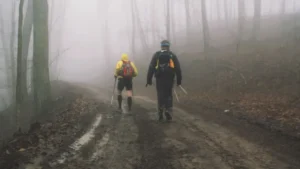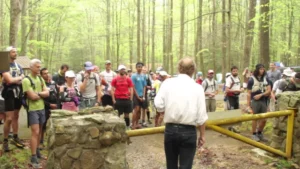In the world of endurance running, an ultramarathon stands as the ultimate test of physical and mental fortitude. These races typically range from 50 kilometres (31 miles) to 100 miles or more, and they often take place in challenging terrains, such as mountains, deserts, or forests. Ultramarathons can be categorised into several types based on distance, time, and format.
The Origins: A Madman’s Dream
The Barkley Marathons began in 1986, born from the eccentric imagination of Gary Cantrell, also known as Lazarus Lake. The inspiration for this grueling race came from the failed escape of James Earl Ray, the assassin of Martin Luther King Jr., who managed to cover just 8 miles after running for 55 hours through the dense woods of Frozen Head State Park in Tennessee. Lake, a passionate ultrarunner, mused that he could do at least 100 miles in the same time. And thus, the Barkley Marathons was conceived—a race so tough that only the most determined and possibly insane athletes would dare to attempt it.
The Application Process: A Test of Creativity
The Barkley Marathons is not your average ultramarathon, and its entry process reflects that. Potential participants must write a letter of application to Lazarus Lake, explaining why they deserve to be part of this legendary event. The letter is as much a test of creativity as it is of determination. Those who are accepted are notified in the most unique way—by receiving a “letter of condolence,” informing them they have been chosen to suffer.
But the quirks don’t stop there. The entry fee is equally unusual: instead of money, first-time runners must bring a license plate from their home state, while past finishers are required to pay with a pack of cigarettes, a tribute to Lazarus Lake’s fondness for smoking. The race does not cater to conventional standards; it thrives on the strange and unconventional.
The Course: A Labyrinth of Pain
The course itself is a 20-mile loop through the rugged terrain of Frozen Head State Park, but calling it just a loop would be an understatement. Runners must complete five laps to finish the 100-mile race, but the challenge lies not only in the distance. The Barkley Marathons features a staggering 54,000 feet of elevation gain, equivalent to climbing Mount Everest—twice. The terrain is unforgiving, with dense forests, steep climbs, and treacherous descents that test even the most experienced ultrarunners.

What makes the course even more brutal is its complete lack of markings. There are no signs, no flags, nothing to guide the runners except for their notes and instincts. Navigation is a key skill, and getting lost is a common occurrence. Runners often find themselves wandering in circles, disoriented and exhausted, as they try to find their way back on course.
The Rituals: A Race Like No Other
The Barkley Marathons is filled with bizarre traditions that add to its mystique. Each year, the race begins when Lazarus Lake lights his cigarette. There’s no gunshot or horn—just the quiet puff of smoke signaling the start of an ordeal that few will survive. This understated beginning is fitting for a race that prides itself on breaking down those who dare to participate.
Another unique aspect of the race is the assignment of bib numbers. Bib #1 is given to the runner least likely to finish even the first lap, humorously dubbed “The Human Sacrifice.” It’s a darkly humorous reminder that the Barkley Marathons is as much a mental challenge as it is a physical one.
As runners traverse the course, they must find books placed at various checkpoints. For each lap, they tear out the page that corresponds to their bib number as proof they completed the lap. This peculiar requirement adds an element of scavenger hunt to the race, further distinguishing it from any other ultramarathon in the world.
When a runner drops out, they are serenaded by the haunting notes of “Taps,” played on a bugle. This military tune, traditionally used to signify the end of the day, serves as a somber farewell to those who couldn’t conquer the Barkley. It’s a final touch of solemnity in a race that is otherwise filled with quirky and punishing details.
The Cutoff: A Race Against Time
Time is another relentless adversary in the Barkley Marathons. The race has a strict cutoff time of 60 hours, and the clock doesn’t stop for anything. Sleep is a luxury, and those who hope to finish must balance their need for rest with the relentless march of time. Even the most seasoned ultrarunners find themselves pushed to their absolute limits, with many succumbing to the overwhelming fatigue, disorientation, and physical toll of the race.
Finishing the Barkley Marathons is not just about physical endurance; it’s about mental fortitude. The combination of sleep deprivation, grueling terrain, and the pressure of the ticking clock forces runners to dig deep into their reserves of willpower. For most, the Barkley Marathons is a battle against themselves—a test to see how far they can go before their mind or body gives out.
The Legacy: A Select Few
In the nearly four decades since its inception, only 20 runners have ever completed the Barkley Marathons. This astonishingly low number of finishers underscores just how difficult the race is. Those who succeed become legends in the ultrarunning community, their names etched into the annals of endurance sports. They are the few who have stared into the abyss of the Barkley Marathons and emerged victorious.
For the rest, the Barkley remains an enigma—a race that defies conventional wisdom and pushes the boundaries of what is possible. It’s a race that laughs in the face of modern ultramarathons with their well-marked trails and generous support systems. The Barkley Marathons is a throwback to a time when races were as much about survival as they were about speed.




